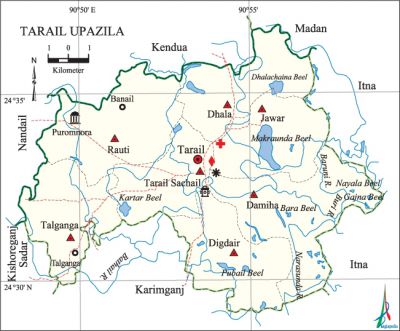Tarail Upazila
Tarail Upazila (kishoreganj district) area 136.88 sq km, located in between 24°30' and 24°37' north latitudes and in between 90°49' and 90°59' east longitudes. It is bounded by kendua and madan upazilas on the north, karimganj upazila on the south, itna upazila on the east, nandail and kishoreganj sadar upazilas on the west.
Population Total 153665; male 78565, female 75100; Muslim 146452, Hindu 7089, Buddhist 12 and others 112.
Water bodies Main rivers: Bathail, Baruni, Narsunda, Buri; Dhalachaina Beel, Makraunda Beel, Kartar Beel, Pubail Beel, Bara Beel, Nayala Beel, Gajna Beel are notable.
Administration Tarail Thana was formed in 1928 and it was turned into an upazila in 1983.
| Upazila | ||||||||
| Municipality | Union | Mouza | Village | Population | Density (per sq km) | Literacy rate (%) | ||
| Urban | Rural | Urban | Rural | |||||
|
- |
7 |
75 |
114 |
8549 |
145116 |
1123 |
65.8 |
31.2 |
| Upazila Town | |||||
|
Area (sq km) |
Mouza |
Population |
Density (per sq km) |
Literacy rate (%) | |
|
2.70 |
1 |
8549 |
3166 |
65.8 | |
| Union | ||||
| Name of union and GO code | Area (acre) | Population | Literacy rate (%) | |
| Male | Female | |||
|
Jawar 54 |
4512 |
11335 |
10461 |
- |
|
Tarail Sachail 94 |
3766 |
12168 |
11351 |
44.81 |
|
Talganga 81 |
4489 |
10774 |
10343 |
44.76 |
|
Damiha 13 |
6592 |
12273 |
12046 |
28.10 |
|
Digdair 40 |
4767 |
9649 |
9516 |
26.98 |
|
Dhala 27 |
4638 |
9908 |
9286 |
24.72 |
|
Rauti 67 |
6042 |
12458 |
12097 |
29.28 |
SourceBangladesh Population Census 2001, Bangladesh Bureau of Statistics.

Archaeological heritage and relics Saheb Bari Mosque at Jawar (941 AH), Mosque at village Parura (Mughal period),' Mosque and Mazar of Saheb Bari at Sekandar Nagar, Kachari Bari (revenue office) of Girish Chandra Pal (1333 BS), memorial monument of Zamindar Raj Chandra Roy.
Religious institutions Mosque 231, temple 12, tomb 1, akhra 1.
Literacy rate and educational institutions Average literacy 33.3%; male 35.3%, female 31.2%. Educational institutions: college 1, secondary school 11, primary school 75, community school 3, madrasa 6. Noted educational institutions: Tarail Muktijoddha College (1992), Tarail Pilot High School (1945), Jawar High School (1903), Parura High School (1961), Talganga Raj Chandra Roy High School (1964), Dhala Multilateral Alim Madrasa (1968), Talganga Union Senior Madrasa (1991).
Cultural organisations Club 31, voluntary organisation 20, cinema hall 2, circus party 1, playground 19.
Main sources of income Agriculture 69.75%, non-agricultural labourer 4.37%, industry 0.36%, commerce 12.18%, transport and communication 2.19%, service 3.10%, construction 0.61%, religious service 0.31%, rent and remittance 0.17% and others 6.96%.
Ownership of agricultural land Landowner 49.78%, landless 50.22%; agricultural landowner: urban 34.86% and rural 50.58%.'
Main crops Paddy, jute, wheat, mustard, chilli, onion.
Extinct or nearly extinct crops Sesame, linseed, black gram, pea, khesari.
Main fruits Mango, jackfruit, litchi, pulm.
Fisheries, dairies and poultries Fishery 21, fish safe shelter 3, dairy 28, poultry 49, hatchery 1.
Communication facilities Pucca road 49.62 km, semi-pucca road 4.06 km, mud road 252.04 km; waterway 11 nautical miles.
Extinct or nearly extinct traditional transport Palanquin, horse carriage, bullock cart.
Noted manufactories Rice mill, saw mill, ice factory, soap factory, bakery.
Cottage industries Goldsmith, blacksmith, potteries, weaving, bamboo and wood work.
Hats, bazars and fairs Hats and bazars are 7, fairs 9, most noted of which are Tarail Bazar, Talganga Bazar, Jawar Bazar and Parura Bazar.
Main exports Paddy, jute, mustard.
Access to electricity All the unions of the upazila are under rural electrification net-work. However 8.70% of the dwelling households have access to electricity.
Sources of drinking water Tube-well 95.87%, tap 0.41%, pond 0.91% and others 2.81%. The presence of arsenic has been detected 25.41% in shallow tube-well water of the upazila.
Sanitation 24.68% (rural 22.04% and urban 74.24%) of dwelling households of the upazila use sanitary latrines and 55.48% (rural 57.30% and urban 21.37%) of dwelling households use non-sanitary latrines; 19.84% of households do not have latrine facilities.
Health centres Upazila health complex 1, family planning centre 4, rural health centre 2.
Natural disasters The floods of 1988 and 2004 caused heavy damages to settlements, livestock and other properties of the upazila.
NGO activities Operationally important NGOs are brac, asa, Swanirvar Bangladesh. [Muhammad Tofazzel Hussain Khan]
References Bangladesh Population Census 2001, Bangladesh Bureau of Statistics; Cultural survey report of Tarail Upazila 2007.
